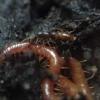First queen to ID I'm pretty certain is Lasius, I just don't know the specific species. They have been flying fairly often since late June here in northern Kentucky. I find them crawling all over sidewalks, driveways, and parking lots. They are a honey brown color and their velvet-like gasters reflect the light giving them a tigers eye gemstone look. I collected 5 or 6 two nights ago at dusk, but they were all over from at least 6pm until 10pm. They are about 9mm long.
The second queen I believe is a Formica, but her gaster is more elongated and less round than previous Formica queens I have had. I caught her last night (7/22/18) in a wooded area climbing a rotting dead tree at about 8pm. She doesn't take pictures well, she is erratic when exposed to light, which is how previous Formica queens have behaved. She is about 10mm long and black. Her gaster segments have a silvery edge to them, as you can see in the third picture.
The third queen I believe is Aphaenogaster. I found an established multiqueen colony while flipping landscaping pavers that surround a mulched tree in my front yard this afternoon (7/23/18). I caught two queens out of the center of the mass of ants and put them in a test tube. Then I let at least two queens and most of the brood escape underground before I started dumping handfuls of mulch full of workers into a sterilite tub. I discovered that I ended up getting even more queens accidentally by doing that when I sorted the ants from the mulch. The workers are a reddish-orange brown color and the queens are a little darker. The queens I'm estimating to be about 9mm long and the workers are about 4-5mm long. I have included pictures of a dead worker, then a picture of at least 4 queens in their formicarium, and lastly a picture of a queen.
Edited by Zafak, July 23 2018 - 7:15 PM.






















